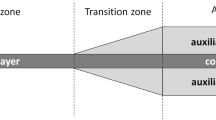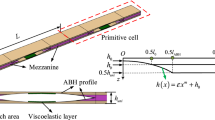Abstract
It is revealed that a hyperelastic material with smooth variation of elastic properties with strain, may serve as an acoustic black hole in respect of harmonic elastic waves. The analysis comprises theoretical method based on thermodynamic analysis, Cauchy formalism, coupled with numerical method utilizing Lax–Wendroff explicit numerical scheme in time domain and finite element discretization in spatial domain. The observed phenomena elucidate the appearance of ABH in hyperelastic media and may be indispensible for development of new types of vibration and shock absorbers, which result in mechanical energy attenuation in a purely elastic system.




Similar content being viewed by others
References
Aklouche, O., Pelat, A., Maugeais, S., Gautier, F.: Scattering of flexural waves by a pit of quadratic profile inserted in an infinite thin plate. J. Sound Vib. 375, 38–52 (2016)
Ambartsumyan, S.A.: The basic equations and relations of the different-modulus theory of elasticity of an anisotropic body. Mech. Solids 4(3), 48–56 (1969)
Arruda, E.M., Boyce, M.C.: A three-dimensional model for the large stretch behavior of rubber elastic materials. J. Mech. Phys. Solids 41(2), 389–412 (1993)
Avesth, P., Mukerji, T., Mavko, G.: Quantitative Seismic Interpretation. Cambridge University Press, Cambridge (2005)
Bayliss, A., Turkel, E.: Radiation boundary conditions for wave-like equations. Commun. Pure Appl. Math. 33, 707–725 (1980)
Belytschko, T., et al.: Hourglass control in linear and nonlinear problems. Comp. Methods Appl. Mech. Eng. 43(3), 251–276 (1984)
Ben-Menahem, A., Singh, S.J.: Seismic Waves and Sources. Springer, Berlin (1981)
Bergstrom, J.S., Boyce, M.C.: Deformation of elastomeric networks: relation between molecular level deformation and classical statistical mechanics models of rubber elasticity. Macromolecules 34(3), 614–626 (2001)
Boyce, M.C., Arruda, E.M.: Constitutive models of rubber elasticity: a review. Rubber Chem. Technol. 73(3), 504–523 (2000)
Brun, M., et al.: Hybrid asynchronous perfectly matched layer for seismic wave propagation in unbounded domains. Finite Elem. Anal. Des. 122, 1–15 (2016)
Cangiani, A., et al.: Hourglass stabilization and the virtual element method. Int. J. Numer. Methods Eng. 102(3–4), 404–436 (2015)
Cellier, F.E., Kofman, E.: Continuous System Simulation. Springer, Berlin (2006)
Clayton, R., Engquist, B.: Absorbing boundary conditions for acoustic and elastic wave equations. Bull. Seism. Soc. Am. 67(6), 1529–1540 (1977)
Cohen, A.: A Padé approximant to the inverse Langevin function. Rheol. Acta 30(3), 270–273 (1991)
Dequiedt, J.L., Stolz, C.: Propagation of a shock discontinuity in an elasto-plastic material: constitutive relations. Arch. Mech. 56(5), 391–410 (2004)
Djeran-Maigre, I., et al.: Velocities, dispersion, and energy of SH-waves in anisotropic laminated plates. Acoust. Phys. 60(2), 200–207 (2014)
Du, Z.L., et al.: A new computational framework for materials with different mechanical responses in tension and compression and its applications. Int. J. Solids Struct. 100–101, 54–73 (2016)
Engquist, B., Majda, A.: Absorbing boundary conditions for the numerical simulation of waves. Math. Comp. 31, 629–652 (1977)
Ericksen, J.L.: On the propagation of waves in isotropic incomprerssible perfectly elastic materials. J. Rational Mech. Anal. 2, 329–337 (1953)
Fletcher, C.A.J.: Comparison of finite-difference, finite-element, and spectral methods. In: Computational Galerkin Methods. Springer Series in Computational Physics, pp. 225–245. Springer, Berlin (1984)
Fu, Y.B., Scott, N.H.: The evolution law of one-dimensional weak nonlinear shock waves in elastic nonconductors. Quart. J. Mech. Appl. Math. 42(1), 23–39 (1989)
Fu, Y.B., Scott, N.H.: The evolution laws of dilatational spherical and cylindrical weak nonlinear shock waves in elastic non-conductors. Arch. Rational Mech. Anal. 108, 11–34 (1989)
Fu, Y.B., Scott, N.H.: One-dimensional shock waves in simple materials with memory. Proc. Roy. Soc. London. Ser. A Math. Phys. Sci 428(1875), 547–571 (1990)
Gavrilov, S.N., Herman, G.C.: Wave propagation in a semi-infinite heteromodular elastic bar subjected to a harmonic loading. J. Sound Vib. 331(20), 4464–4480 (2012)
Gent, A.N.: A new constitutive relation for rubber. Rubber Chem. Tech. 69, 59–61 (1996)
Givoli, D., Keller, J.B.: Non-reflecting boundary conditions for elastic waves. Wave Motion 12(3), 261–279 (1990)
Givoli, D.: Non-reflecting boundaries: high-order treatment. In: Givoli, D., Grote, M.J., Papanicolaou, G.C. (eds.) A Celebration of Mathematical Modeling. Springer, Dordrecht (2004)
Goldstein, R.V., et al.: The modified Cam-Clay (MCC) model: cyclic kinematic deviatoric loading. Arch. Appl. Mech. 86(12), 2021–2031 (2016)
Goldstein, R.V., et al.: Long-wave asymptotics of Lamb waves. Mech. Solids 52(6), 700–707 (2017)
Häggblad, B., Sundberg, J.A.: Large strain solutions of rubber components. Comput. Struct. 17, 835–843 (1983)
Hook, K., Cheer, J., Daley, S.: Control of vibration in a plate using active acoustic black holes. Smart Mater. Struct. 31(3), 035033 (2022)
Horgan, C.O., Saccomandi, G.: A molecular-statistical basis for the Gent constitutive model of rubber elasticity. J. Elast. 68(1), 167–176 (2002)
Hu, X., Ng, C.-T., Kotousov, A.: Numerical and experimental investigations on mode conversion of guided waves in partially immersed plates. Measurement 190, 110750 (2022)
Ilyashenko, A.V., et al.: Theoretical aspects of applying Lamb waves in nondestructive testing of anisotropic media. Russ. J. Nondestruct. Test. 53, 243–259 (2017)
Ilyashenko, A.V., et al.: Pochhammer–Chree waves: polarization of the axially symmetric modes. Arch. Appl. Mech. 88, 1385–1394 (2018)
Jones, R.M.: Stress-strain relations for materials with different moduli in tension and compression. AIAA J. 15(1), 16–23 (1977)
Kaliske, M., Rothert, H.: On the finite element implementation of rubber-like materials at finite strains. Eng. Comput. 14(2), 216–232 (1997)
Khanna, G.: High-precision numerical simulations on a CUDA GPU: Kerr black hole tails. J. Sci. Comput. 56(2), 366–380 (2013)
Kravtsov, A.V., et al.: Finite element models in Lamb’s problem. Mech. Solids 46, 952–959 (2011)
Krylov, V.V.: Acoustic black holes for flexural waves: a smart approach to vibration damping. Proc. Eng. 199, 56–61 (2017)
Kuznetsov, S.V.: Fundamental and singular solutions of Lamé equations of media with arbitrary anisotropy. Quart. Appl. Math. 63(3), 455–467 (2005)
Kuznetsov, S.V.: Seismic waves and seismic barriers. Acoust. Phys. 57(3), 420–426 (2011)
Kuznetsov, S.V.: Abnormal dispersion of flexural Lamb waves in functionally graded plates. Zeit. Angew. Math. Phys. 70(3), 89 (2019)
Kuznetsova, M., Khudyakov, M., Sadovskii, V.: Wave propagation in continuous bimodular media. Mech. Adv. Mater. Struct. 29(21), 3147–3162 (2022)
Lax, P.D.: Hyperbolic Systems of Conservation Laws and the Mathematical Theory of Shock Waves. SIAM, Philadelphia (1972)
Li, D., et al.: Evaluation of bi-modular behavior of rocks subjected to uniaxial compression and Brazilian tensile testing. Rock Mech. Rock Eng. 54, 3961–3975 (2021)
Li, H., et al.: A vibro-impact acoustic black hole for passive damping of flexural beam vibrations. J. Sound Vib. 450(23), 28–46 (2019)
Li, S., et al.: Hybrid asynchronous absorbing layers based on Kosloff damping for seismic wave propagation in unbounded domains. Comput. Geotech. 109(1), 69–81 (2019)
Li, S., et al.: Explicit/implicit multi-time step co-simulation in unbounded medium with Rayleigh damping and application for wave barrier. Eur. J. Environ. Civil Eng. 24(14), 2400–2421 (2020)
Li, S., et al.: Benchmark for three-dimensional explicit asynchronous absorbing layers for ground wave propagation and wave barriers. Comput. Geotech. 131, 103808 (2021)
Lucchesi, M., Pagni, A.: Longitudinal oscillations of bimodular rods. Int. J. Struct. Stabil. Dyn. 5(1), 37–54 (2005)
Marckmann, G., Verron, E.: Comparison of hyperelastic models for rubber-like materials. Rubber Chem. Technol. 79(5), 835–858 (2006)
Medri, G.: A nonlinear elastic model for isotropic materials with different behavior in tension and compression. ASME J. Eng. Mater. Technol. 104(1), 26–28 (1982)
Mironov, M.: Propagation of a flexural wave in a plate whose thickness decreases smoothly to zero in a finite interval. Sov. Phys. Acoust. 34, 318–319 (1988)
Mori, A., et al.: Compression behaviour of bridge bearings used for seismic isolation. Eng. Struct. 18(5), 351–362 (1996)
Naeeni, M.R., Eskandari-Ghadi, M., Ardalan, A.A., Pak, R.Y.S., Rahimian, M., Hayati, Y.: Coupled thermoviscoelastodynamic Green’s functions for bi-material half-space. Z. Angew. Math. Mech. 95, 260–282 (2015)
O’Boy, D.J., Krylov, V.V., Kralovic, V.: Damping of flexural vibrations in rectangular plates using the acoustic black hole effect. J. Sound Vib. 329(22), 4672–4688 (2010)
Ogden, R.W.: Non-Linear Elastic Deformations. Dover, New York (1984)
Oh, J., Kim, J.H., Yi, H.C.: Effects of thermal aging of laminated rubber bearing on seismic performance of bridges. J. Vibroeng. 18(6), 3782–3797 (2016)
Pelat, A., Gautier, F., Conlon, S.C., Semperlotti, F.: The acoustic black hole: a review of theory and applications. J. Sound Vibr. 476, 115316 (2020)
Rickaby, S.R., Scott, N.H.: A comparison of limited-stretch models of rubber elasticity. Int. J. Non-Linear Mech. 68, 71–86 (2015)
Sadoulet-Reboul, E., Matten, G., Yi, K., Ouisse, M.: Passive discrete lens for broadband elastic guided wave focusing. J. Theor. Comp. Appl. Mech. Pap. (2021)
Tang, L., et al.: Characterization of acoustic black hole effect using a one-dimensional fully-coupled and wavelet-decomposed semi-analytical model. J. Sound Vib. 374, 172–184 (2016)
Tang, L., Cheng, L.: Broadband locally resonant band gaps in periodic beam structures with embedded acoustic black holes. J. Appl. Phys. 121, 194901 (2017)
Tang, Y., et al.: Dynamic characteristic analysis of acoustic black hole in typical raft structure. Rev. Adv. Mater. Sci. 61(1), 458–476 (2022)
Tezuka, A.: Finite element and finite difference methods. In: Czichos, H., Saito, T., Smith, L. (eds.) Springer Handbook of Materials Measurement Methods, pp. 973–1000. Springer, Berlin (2006)
Thomée, V.: The finite difference versus the finite element method for the solution of boundary value problems. Bull. Austr. Math. Soc. 29(2), 267–288 (1984)
Ting, L., Miksis, M.J.: Exact boundary conditions for scattering problems. J. Acoust. Soc. Am. 80, 1825–1827 (1986)
Truesdell, C.: General and exact theory of waves in finite elastic strain. Arch. Rat. Mech. Anal. 8, 263–296 (1961)
Truesdell, C., Noll, W.: The Non-Linear Field Theories of Mechanics. Springer, Berlin (2004)
Wex, C., et al.: Isotropic incompressible hyperelastic models for modelling the mechanical behaviour of biological tissues: a review. Biomed. Tech. 60(6), 577–592 (2015)
Xu, Z., Shu, C.-W.: Third order maximum-principle-satisfying and positivity-preserving Lax–Wendroff discontinuous Galerkin methods for hyperbolic conservation laws. J. Comput. Phys. 470, 111591 (2022)
Zafati, E., et al.: Design of an efficient multi-directional explicit/implicit Rayleigh absorbing layer for seismic wave propagation in unbounded domain using a strong form formulation. Int. J. Numer. Methods Eng. 106, 83–112 (2015)
Zemanek, J.: An experimental and theoretical investigation of elastic wave propagation in a cylinder. J. Acoust. Soc. Am. 51, 265–283 (1972)
Zhao, C., Zhang, T., How, G.X.: Finite-difference time-domain modeling for underwater acoustic scattering applications based on immersed boundary method. Appl. Acoust. 193, 108764 (2022)
Author information
Authors and Affiliations
Contributions
I am the only author.
Corresponding author
Ethics declarations
Conflict of interest
The author declares no competing interests.
Additional information
Publisher's Note
Springer Nature remains neutral with regard to jurisdictional claims in published maps and institutional affiliations.
Rights and permissions
Springer Nature or its licensor (e.g. a society or other partner) holds exclusive rights to this article under a publishing agreement with the author(s) or other rightsholder(s); author self-archiving of the accepted manuscript version of this article is solely governed by the terms of such publishing agreement and applicable law.
About this article
Cite this article
Kuznetsov, S.V. Acoustic black hole in a hyperelastic rod. Z. Angew. Math. Phys. 74, 122 (2023). https://doi.org/10.1007/s00033-023-02020-x
Received:
Revised:
Accepted:
Published:
DOI: https://doi.org/10.1007/s00033-023-02020-x




